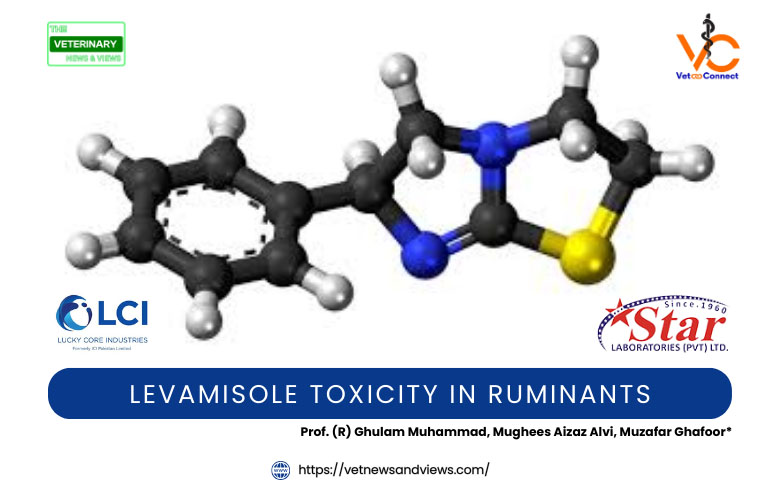Prof. (R) Ghulam Muhammad, Mughees Aizaz Alvi, Muzafar Ghafoor*
*Corresponding author: muzafar1512@gmail.com

Levamisole is a commonly used imidathiazole anthelmintic in ruminants in Pakistan and other countries. Several brands (e.g. Nilverm® drench, LCI Pakistan; Vermisole®, Star Lab. Pakistan) of this anthelmintic are available in the market. It acts as an acetylcholinesterase and hydrolyzes acetylcholine. Acetylcholine is involved in the transmission of nerve signals from nerves to muscles (Plumb, 2008). Levamisole causes death of the susceptible worms by depolarization of the ganglions and nerve cells of the nematode parasites. It is usually administered orally @ 8mg/kg b.wt. to sheep, cattle and buffaloes. Goats metabolize this drug faster than sheep, cattle and buffalo and thus require 1.5 times higher dose (i.e. 12mg/kg b.wt. orally) than the dose for other ruminants. Most oral brands of levamisole contain 15mg/ml of this drug. In some countries, injectable formulations of levamisole are also available. Overdosing and treatment of weak and sick animals may cause levamisole toxicity characterized clinically by cholinergic signs such as excessive salivation, urination, colic, diarrhea, bradycardia, rapid and difficult respiration, convulsions, trembling, ataxia, miosis (i.e. constriction of pupils) and the occasional death due to respiratory failure (Dar et al., 2020; Muller and Dwyer, 2016; Vercruysse and Claerebout, 2022). It is important to remember that these toxicity signs typically appear very quickly (within 5-15 minutes) and disappear 1-6 hours after oral administration of toxic doses. Levamisole toxicity is usually diagnosed by history of deworming with a product containing this anthelmintic, clinical signs, appearance of signs within 15 minutes of dosing with the drug and disappearance of signs 1-6 hours after oral exposure to this anthelmintic. Postmortem findings in fatal cases include discoloration and inflammation of liver, congestion of lungs and petechial hemorrhages in kidneys (Dar et al., 2020). There is no specific antidote of levamisole. As indicated above, toxicity symptoms appear shortly after overdosing and last for a short time. Therefore, in most cases, there is really no time to treat animals suffering from levamisole overdosing toxicity (https://www.abvt.org/public/docs/reviewofveterinaryantidotes). In less severe cases, it is useful to treat CNS and parasympathetic symptoms.
Treatment
- Inject atropine sulphate (e.g. Inj. Atrosin® 1mg/ml, P.D.H. Lab. Pvt. Ltd. Pakistan or Inj. Atrostar® 1mg/ml, Star Labs. Lahore; there are several human brands as well) @ 0.3-0.5 mg/kg b.wt. 1/4th dose IV with the remainder subcutaneously or IM
(https://www.abvt.org/public/docs/reviewofveterinaryantidotes;http://parasitipedia.net/index.php?option=com_content&view=article&id=2696&Itemid=2997; Sharma et al., 2020).
- Immediately after noticing the first sign of toxicity, administer universal antidote (i.e. activated charcoal @ 1-4 gram/kg b. wt. dissolved in water @ 1 gram of activated charcoal to 8 ml of water) by using a stomach tube. After 30 minutes, administer a saline cathartic such as magnesium sulphate @ 1 gram/kg b. wt. through the stomach tube.
- Inject a neurotonic (e.g. Inj. Neurobion®, Merck Pharma, Pakistan; contains vitamin B1, B6 & B12) @ 3-6 ml IM for adult sheep/goat and 15-24 ml IM, BID (Sharma et al., 2020).
- If arrangements exist, give artificial respiration with O2.
- Give parenteral fluid therapy using 10% dextrose solution, administer a liver tonic (e.g. Inj. Hepasel®), vitamin B complex and dexamethasone (Dar et al., 2020).
Notes:
- Levamisole has a narrow margin of safety and toxicity due to overdosage can occur quite easily if the dose is not based on the actual body weight of the animal (Muller and Dwyer, 2016).
- When levamisole is used to treat lungworm infestation, the treated animals sometimes may cough for 15-30 minutes following administration of levamisole drench. During this coughing period, adult lungworms are removed from the bronchi. This cough should not be a cause of concern for anyone.
- Levamisole is considered safe in pregnant animals. However, its use in advanced pregnancy may preferably be avoided.
Modified from:
Dar, P. A., S. A. Ahanger, M. A. Rather, and M. Shah, 2020. Lemisole toxicity in sheep: case study. Anim. Sci. Quarterly. 1(1):36-37.
Vercruysse, J., and E. Claerebout, 2022. Safety of anthelmintics. MSD Veterinary Manual. Merck Sharp & Dohme Corp., a subsidiary of Merck & Co., Inc., Kenilworth, NJ, USA.
Hare, W., L.O. Post and F.Oehme. A review of veterinary antidotes. Accessed from https://www.abvt.org/public/docs/reviewofveterinaryantidotes.
Muller, K. R., and C. Dwyer, 2016. Suspected levamisole intoxication in calves. Newzealand Vet. J., 64(4):257-260.
Plumb, D.C., 2008. Veterinary Drug Handbook. Iowa State University. Press, Ames, Iowa, USA.
Sharma, N., A. Rahal, A. Mishra, V. Chaturvedi, C. Gangwar, and G. Das, 2020. Successful management of levamisole toxicity in sheep: a case report. Vet. Clin. Sci., 8(3):73-74.